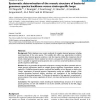Free Online Productivity Tools
i2Speak
i2Symbol
i2OCR
iTex2Img
iWeb2Print
iWeb2Shot
i2Type
iPdf2Split
iPdf2Merge
i2Bopomofo
i2Arabic
i2Style
i2Image
i2PDF
iLatex2Rtf
Sci2ools
BMCBI
2005
2005
Systematic determination of the mosaic structure of bacterial genomes: species backbone versus strain-specific loops
Background: Public databases now contain multitude of complete bacterial genomes, including several genomes of the same species. The available data offers new opportunities to address questions about bacterial genome evolution, a task that requires reliable fine comparison data of closely related genomes. Recent analyses have shown, using pairwise whole genome alignments, that it is possible to segment bacterial genomes into a common conserved backbone and strainspecific sequences called loops. Results: Here, we generalize this approach and propose a strategy that allows systematic and nonbiased genome segmentation based on multiple genome alignments. Segmentation analyses, as applied to 13 different bacterial species, confirmed the feasibility of our approach to discern the 'mosaic' organization of bacterial genomes. Segmentation results are available through a Web interface permitting functional analysis, extraction and visualization of the backbone/loops structure of docu...
| Added | 15 Dec 2010 |
| Updated | 15 Dec 2010 |
| Type | Journal |
| Year | 2005 |
| Where | BMCBI |
| Authors | Hélène Chiapello, I. Bourgait, F. Sourivong, G. Heuclin, Annie Gendrault-Jacquemard, Marie-Agnès Petit, Meriem El Karoui |
Comments (0)

